Suwannee County is a land rich in history, from Native American villages to Spanish mission sites to the last 200 years of American ownership under which the County has prospered. Although many of these historic sites are long gone, there remain many reminders of Suwannee County’s past, including, 100+ year-old buildings in downtown Live Oak and remains of spring resorts once world-renowned for their supposed healing powers.
A Brief History of Suwannee County, Florida
Surrounded on three sides and named for the famed Suwannee River, Suwannee County was established on December 21, 1858, but its roots lie far deeper. Originally occupied by Native Americans, the land that would become Suwannee County was traversed by Spanish explorers in the 1500s and 1600s who left behind Catholic missions to colonize the wilderness before being abandoned or destroyed in the ensuing centuries. Resettled by Americans after the War of 1812, the county’s population grew because of railroads that by the end of the 1800s crisscrossed the landscape, transporting timber, turpentine, cotton, and agricultural products throughout the Southeast. The county’s reign as a major source of Sea Island Cotton came to an end during World War I when the boll weevil eliminated the crops and forced the citizens to shift to tobacco production, which became a main source of income until the 1970s. Agriculture is still a top source of income, with ecotourism rapidly growing as people from all around the world flock to Suwannee County to visit the springs, dive the numerous caves, and enjoy the peace and quiet of nature.
Must-Visit Historical Places in Suwannee County
Suwannee County is full of existing sites and buildings that offer a glimpse into the county’s rich history and heritage. These historic sites chronicle the journeys of the citizens of this great county, from the earliest settlers to the present day. Although the long-time county seat of Live Oak has many of the historic sites, the rest of the county has its own ties to Suwannee County’s history as well.
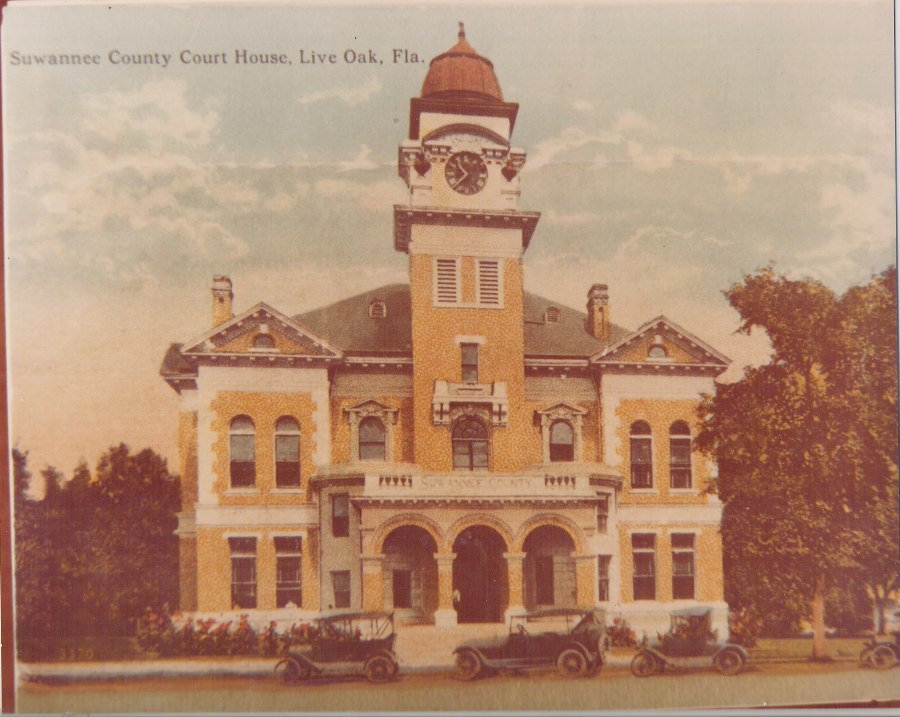 Suwannee County Courthouse
Suwannee County Courthouse
1. The Suwannee County Courthouse
- Location: 200 South Ohio Avenue, Live Oak
- Historical Significance: The historic Suwannee County Courthouse was constructed in 1904 in the Queen Anne style at a time when Live Oak was the fifth largest city in the State of Florida. For 120 years, the building has served as the center of County government, with an expansion added in 1964 to allow for the growth in population and services. Today, it is one of the oldest courthouses in Florida still used as such.
- Highlights: The Suwannee County Courthouse has been the location of practically every court case handled by Suwannee County since 1904, including such infamous cases as the trials of Ruby McCollum and Ted Bundy (before his trial was moved to Central Florida). The Courthouse is also the location of the Official Records of Suwannee County, providing 150+ years of County history.
- Visitor Information: Although certain spaces are not open to the public due to the nature of the work, most of the Courthouse is open to the public for free between 8:00-4:30. Guided tours are available upon request, mainly depending upon when court is in session.
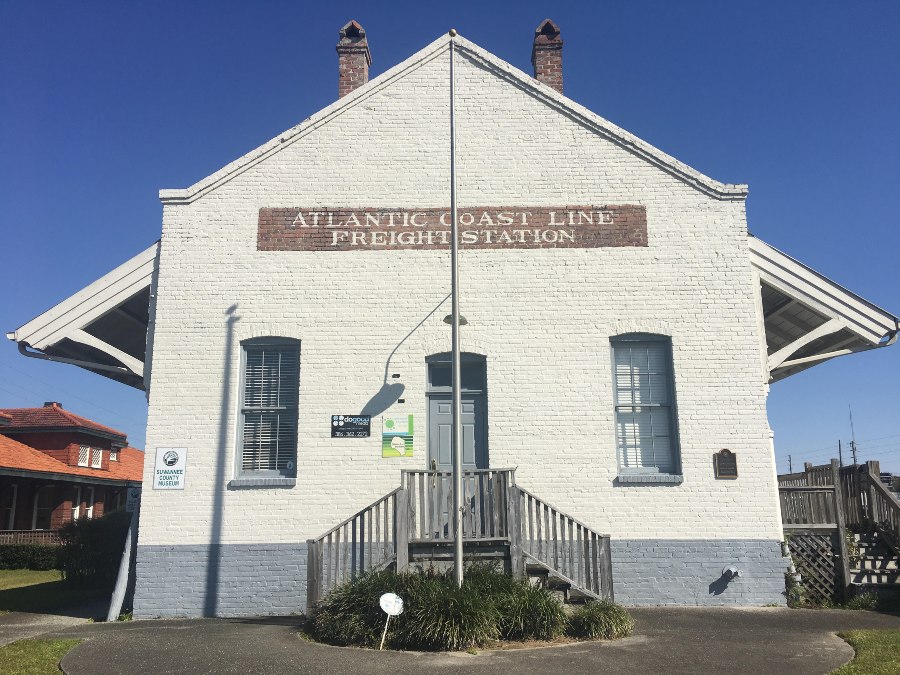 Suwannee County Historical Museum
Suwannee County Historical Museum
2. Suwannee County Historical Museum
- Location: 208 North Ohio Avenue, Live Oak
- Historical Significance: The Suwannee County Historical Museum was originally constructed in 1903 as the Freight Depot for the Atlantic Coast Line (ACL) Railroad, replacing a nearby structure that had outlived its usefulness. For more than 60 years, the depot was a busy stop for farmers and businessmen along the ACL and its successor railroads until markets shifted from Suwannee County. Abandoned for over 20 years, the building was purchased by a non-profit organization in the 1980s and renovated for use as the Suwannee County Historical Museum, in which capacity it remains today.
- Highlights: The Suwannee County Historical Museum is a relic of the heyday of cotton and agriculture in this area, when hundreds of local farmers would line up during harvest time to deliver their goods to waiting railroad cars for shipment across the United States.
- Visitor Information: The Suwannee County Historical Museum is open to the public for self-guided tours on Fridays and Saturdays from 10-4. Entrance into the museum is free, and guided tours by museum staff are available upon request.
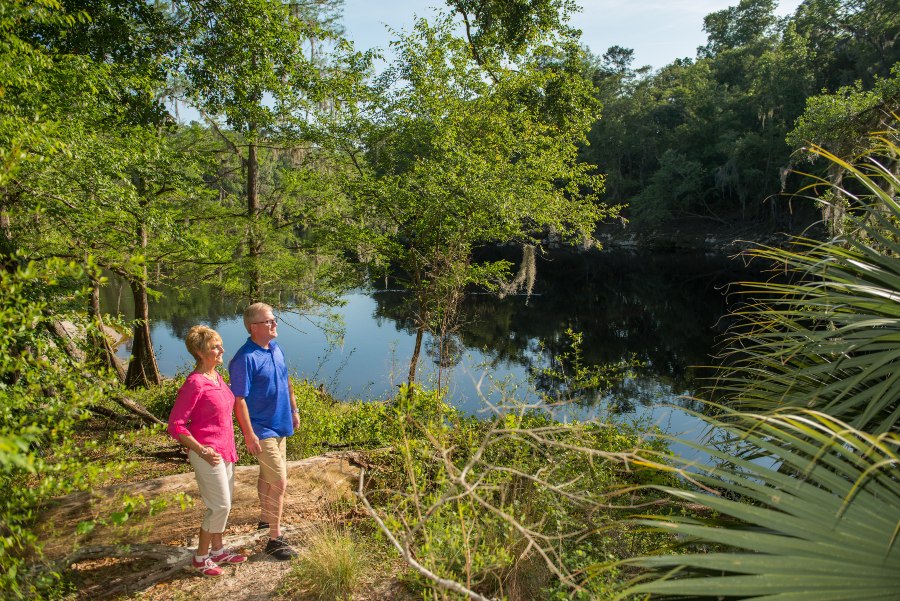 Suwannee River State Park
Suwannee River State Park
3. Suwannee River State Park
- Location: 20185 County Road 132, Live Oak
- Historical Significance: The Suwannee River State Park, purchased in 1936 and opened to the public in 1951, was the site of the once-flourishing town of Columbus, now nothing more than a few scattered ruins along the banks of the Suwannee River.
- Highlights: One of the earliest American communities in Suwannee County, the town of Columbus was established by 1842 at the confluence of the Suwannee and Withlacoochee Rivers. Quickly growing to more than 500 people, the community had stores, mills, and a steamboat landing for goods being shipped to and from other regions of the South. A railroad bridge was completed over the Suwannee River at Columbus in 1861, and it was this bridge that was a major objective of Union forces that were defeated at the Battle of Olustee, Florida’s largest Civil War battle. Nearby are the ruins of the home of the first post-Reconstruction governor, George Franklin Drew.
- Visitor Information: The Suwannee River State Park is open to the public from 8 a.m. until sunset, 365 days a year. There is an entry fee of $5 per vehicle. Self-guided tours and trails are available.
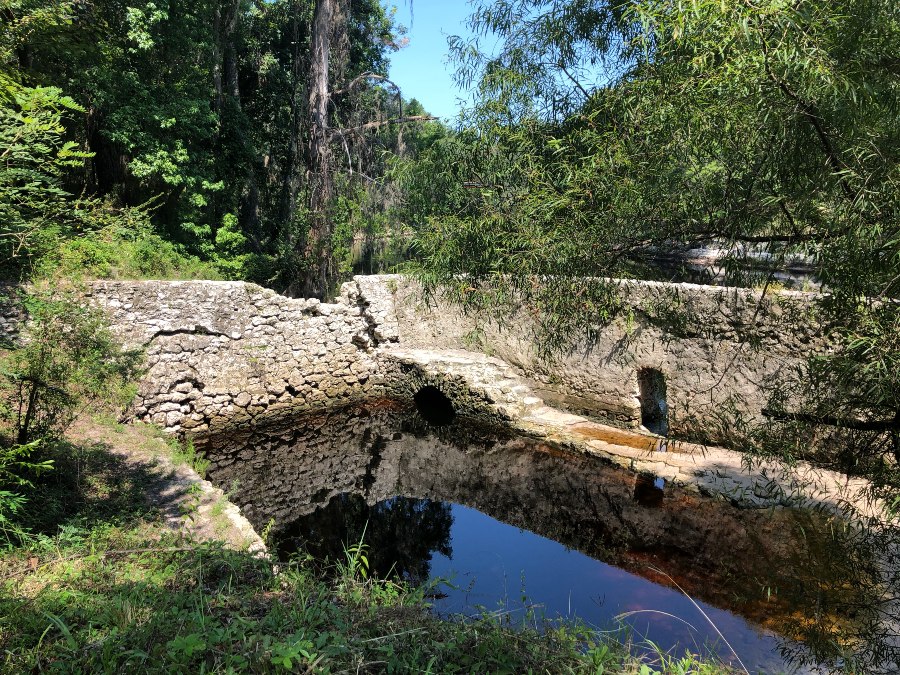 Suwannee Springs
Suwannee Springs
4. Suwannee Springs
- Location: 3243 91st Drive, Live Oak
- Historical Significance: Suwannee Springs has long served as a source of relief, relaxation, and enjoyment for many people over the centuries. Several resorts were built on the site from the 1830s through the 1920s, but little remains of them except for a few scattered ruins and the retaining wall for the spring, built out of local materials.
- Highlights: Known by various names over its history, Suwannee Springs, a sulfur spring used for centuries by the Native Americans, was the location of the earliest known chartered American community in Suwannee County, Gadsden Spring (in 1832) and its successor Readsville (1837). Suwannee Springs was the location of at least four resorts, dating from the 1830s all the way through the 1920s, where travelers would go to relax and bathe in the therapeutic waters, hunt, fish, or travel along the Suwannee River. By the early 1900s, scientific advances had determined that the sulfur waters did not have healing powers, and this, coupled with the loss of the hotels due to fires, led to the downfall of Suwannee Springs as a result. Today, the site is a county park, with the retaining wall around the spring providing a visible connection to its illustrious history. Adjoining the property is the Suwannee Springs Bridge, also known as the “Graffiti Bridge,” the old US 129 vehicle bridge constructed in 1931 that is now only open to foot traffic. Graffiti artists routinely cover the bridge in various exquisite designs, and the bridge has become a popular site for photos overlooking Suwannee Springs.
- Visitor Information: Access to Suwannee Springs is free and open to the public from sunrise to sunset. Self-guided tours along various trails are available, and a boat ramp accessing the Suwannee River is on the premises.
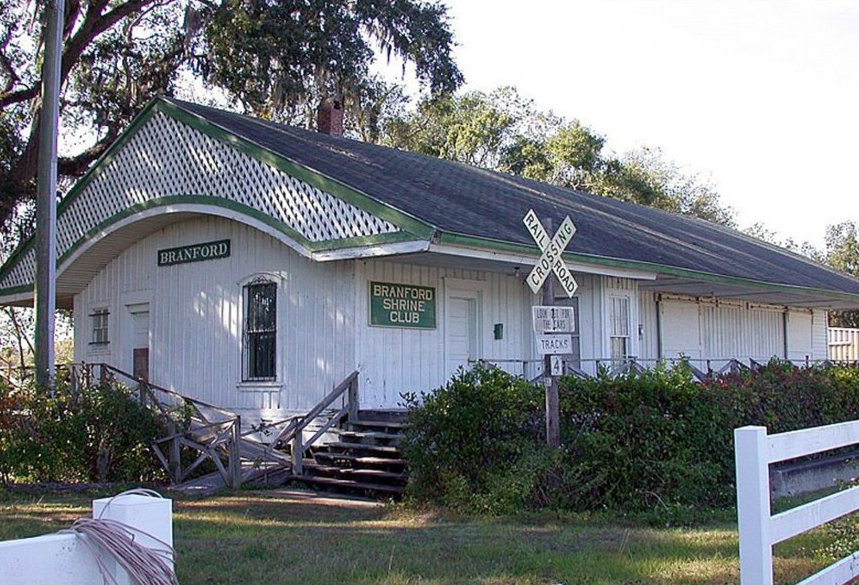 Branford Railroad Depot
Branford Railroad Depot
5. Branford Railroad Depot (AKA Branford Shrine Club)
- Location: 307 NW Sugar Hill Street, Branford
- Historical Significance: The Branford Railroad Depot, also known as the Branford Shrine Club, was built circa 1880 to serve as a depot for the Live Oak & Rowland’s Bluff Railroad that was completed as a branch of the larger Savannah, Florida & Western Railroad owned by Henry Plant. The building was moved eastward about 100 feet to better link with the railroad, with a dock that led directly to it from the Suwannee River. After the successor line to the railroad shut down, the depot was sold to the Branford Shrine Club in 1982 and moved approximately 500 feet to the banks of the Suwannee River, where it continues to operate today as the clubhouse for the Branford Shrine Club. It appears to be the only remaining railroad depot along the Suwannee River that served steamboats during their heyday in the last decades of the Nineteenth Century.
- Visitor Information: The Branford Shrine Club is available for rent. Please contact the Branford Shrine Club for further details and availability.
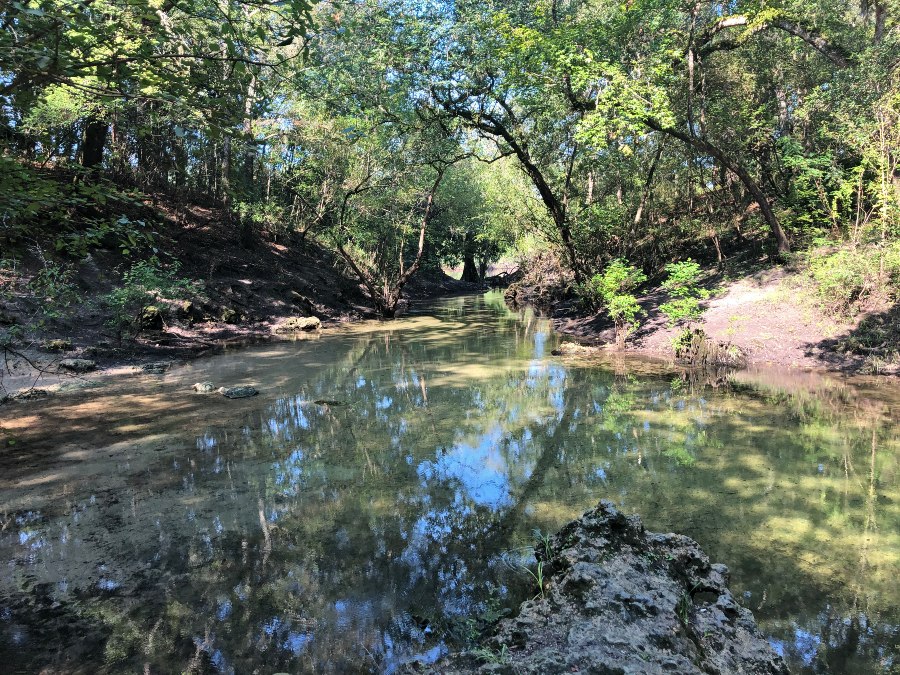 Charles Springs
Charles Springs
6. Charles Springs
- Location: 15465 237th Drive, Live Oak
- Historical Significance: Charles Springs has a long history, beginning with its use by Native Americans. When the Spanish took over Florida, they established a mission and ferry at the location to allow travel along the Camino Real, the Spanish Royal Road, between St. Augustine and Pensacola. Some of the first American settlers in Suwannee County, Ruben (Reuben) and Rebecca Charles, established a trading post, ferry, and inn at the location of Charles Springs in the early 1820s, which became the crossing point of the first federal highway in Florida. After the deaths of Ruben and Rebecca Charles in different circumstances about 1836 and 1852, the ferry, trading post, and inn lost their importance due to more modern and accessible modes of transportation.
- Highlights: It is possible that Spanish conquistador Panfilo de Narvaez and his men crossed the Suwannee River at this location in 1528 during the first European expedition into this interior portion of Florida, and perhaps Hernando de Soto and his men did the same in 1539. The graves of Ruben and Rebecca Charles, along with several children, are located a short distance from the springs that bear their name, with access via a walking trail from the County-owned park. Buried remains of a Timucuan village and adjoining Spanish mission are located close to Charles Springs on private property and are off limits to the public.
- Visitor Information: Access to Charles Springs is free and open to the public from sunrise to sunset. Self-guided tours along various trails are available, and a boat ramp accessing the Suwannee River is located on the premises.
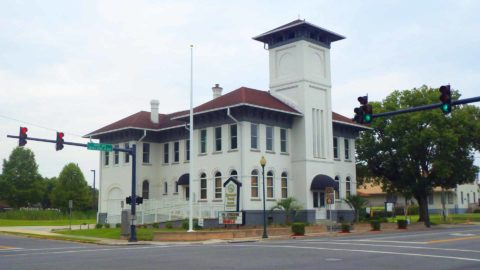 The Old Live Oak City Hall
The Old Live Oak City Hall
7. The Old Live Oak City Hall
- Location: 212 North Ohio Avenue, Live Oak
- Historical Significance: The Old Live Oak City Hall was completed in 1909 to serve what at the time was one of the largest cities in Florida. The structure was designed by a local architect, constructed by a local contractor, and used locally produced building materials. Old City Hall served its original purpose for 65 years, when a new City Hall was constructed several blocks away and many City government functions moved out. The building continued to be used by the Live Oak Fire Department and Live Oak Police Department through the end of the 20th Century before the historic structure was entirely renovated. It is now the location of the Suwannee County Chamber of Commerce.
- Highlights: See hoofmarks made by fire department horses from the early 1900s as they readied themselves to face fires in their first-floor stall and graffiti scribbled in the former jail cell by city prisoners, both conserved for future generations.
- Visitor Information: Although currently occupied by the Chamber of Commerce, visitors are welcome to view the renovated building during working hours upon request.
Historic Walking Tours in Suwannee County, FL
Historic walking tours are an appealing and immersive way to explore the county’s historic sites and landmarks that are near one another. What better way to observe history than by visiting it in person! Plus, you can get in your daily walking steps in the process!
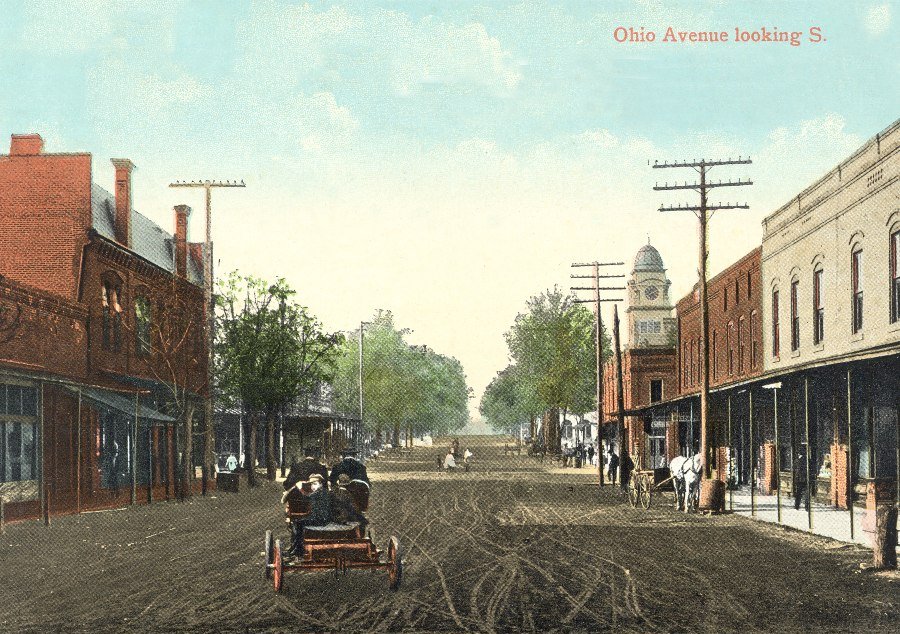 Downtown Live Oak, Florida
Downtown Live Oak, Florida
Downtown Live Oak Historic Walking Tour
To assist visitors with walking tours, the Suwannee County Historical Commission provides a self-guided tour through the Geotourist app under “Live Oak, Florida Heritage Square Walking Tour.”
- Route: Walkable locations for this self-guided Geotourist app tour include:
- Atlantic Coast Line Freight Depot (Suwannee County Historical Museum)
- Union Passenger Depot (North Florida College Satellite Campus)
- Old Live Oak City Hall
- “Old Betsy” fire engine at the Live Oak Fire Department
- Dowling Water Tower
- Dowling House (The 406 Restaurant)
- Visitor Information: The tour is self-guided. The total distance is approximately ¼ mile and can last anywhere between 1 hour and 3 hours, depending upon how long you visit the Suwannee County Historical Museum. As a self-guided tour, the cost is free.
- Tips: You should wear comfortable walking shoes and bring water or some other source of refreshment, especially during summer when the weather is the hottest. It is recommended that you take this tour during daylight hours when many of these buildings and businesses are open.
Plan Your Visit to Suwannee County’s Historic Sites
Don’t miss some of Suwannee County’s historic sites. Whether it’s in the “hustle and bustle” of downtown Live Oak to the quiet banks of the Suwannee River, there are historical locations and tours for many interests and ages. Plan your visit and book a stay in one of Suwannee County’s national hotel chains, campgrounds, a cozy bed and breakfast, or one of the increasing amount of Airbnbs that are found throughout this quiet rural community!
Written by Eric Musgrove

Eric Musgrove is a seventh-generation native of Suwannee County, Florida. Growing up on the family’s country homestead, he quickly developed a love for history that has remained strong throughout his life. Eric married his college sweetheart, Sarah, in 1998, and they live near Live Oak with their two children, Alex and Abby. Eric has authored five published books: Reflections of Suwannee County, Suwannee Memories, There Let Me Live and Die, Images of America: Suwannee County, and Lost Suwannee County.